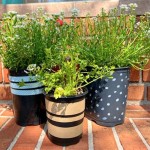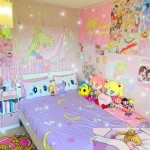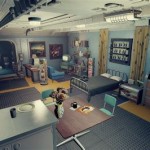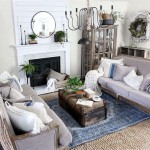How To Decorate a Big Empty Kitchen Wall
A large, blank kitchen wall can present both a design challenge and an opportunity. The expanse of empty space can make the kitchen feel incomplete or even sterile. However, with careful planning and the right decorative elements, this space can become a focal point, adding character, functionality, and visual interest to the entire kitchen.
The key to successfully decorating a large kitchen wall lies in considering the overall style of the kitchen, the existing color palette, and the practical needs of the space. A successful design will integrate seamlessly with the rest of the kitchen, enhancing its aesthetics and potentially even adding storage or organizational solutions. This article explores various strategies for transforming a large, empty kitchen wall into a visually appealing and functional area.
Maximizing Functionality with Storage and Organization
One of the most practical approaches to decorating a large kitchen wall is to incorporate storage and organizational solutions. This is particularly beneficial in kitchens with limited cabinet space or those seeking to declutter countertops. The types of storage options available are vast and can be tailored to suit individual needs and preferences.
Open shelving is a popular choice for adding both storage and visual interest. Shelves can be constructed from various materials, including wood, metal, and glass, each offering a different aesthetic. Open shelving allows for the display of frequently used items such as dishes, cookware, and cookbooks, making them easily accessible. Decorative items like plants, artwork, and decorative bowls can also be incorporated to add personality.
For a more concealed storage solution, consider installing cabinets or a pantry unit along the wall. Cabinets can be customized to match the existing kitchen cabinetry, creating a seamless and cohesive look. A pantry provides ample space for storing food items, small appliances, and other kitchen essentials, helping to keep the countertops clear and organized. The interior of cabinets can be further optimized with pull-out shelves, drawer dividers, and other organizers to maximize storage efficiency.
Another option is to utilize pegboards or magnetic knife strips for hanging cookware and utensils. Pegboards offer a versatile and customizable storage solution, allowing items to be easily rearranged as needed. Magnetic knife strips provide a safe and space-saving way to store knives, keeping them within easy reach while freeing up drawer space. These solutions add a functional and visually appealing element to the wall.
A pot rack is a classic and functional addition to a kitchen wall. Suspended from the ceiling or mounted directly to the wall, a pot rack provides a convenient place to store pots, pans, and other cookware. This frees up cabinet space and allows for easy access to frequently used items. Pot racks come in various styles and materials, allowing for integration with the kitchen's overall design aesthetic.
When incorporating storage solutions, it is important to consider the accessibility of the items being stored. Items that are frequently used should be placed within easy reach, while less frequently used items can be stored on higher shelves or in less accessible areas. Proper organization is key to maximizing the functionality of the storage space and preventing clutter.
Creating a Visual Focal Point with Art and Décor
A large, empty kitchen wall provides an excellent canvas for creating a visual focal point. Utilizing art and décor can transform the wall from a blank slate into a vibrant and engaging element within the kitchen. The type of art and décor chosen should complement the overall style of the kitchen and reflect the personal taste of the homeowner.
Large-scale artwork can make a dramatic statement on a kitchen wall. A single, oversized painting or print can instantly draw the eye and add a splash of color and personality to the space. Consider the color palette of the kitchen when selecting artwork, choosing pieces that complement or contrast with the existing hues. Abstract art, landscapes, and still life paintings are all popular choices for kitchen décor.
A gallery wall, consisting of multiple smaller pieces of art, can also be used to create a visually interesting focal point. Gallery walls allow for a more eclectic and personalized display, showcasing a collection of artwork, photographs, and other decorative items. When creating a gallery wall, it is important to consider the spacing and arrangement of the pieces, ensuring a cohesive and balanced look. Use similar frames or mats to unify the collection, or mix and match different styles for a more eclectic aesthetic.
Decorative mirrors can add depth and dimension to a kitchen, making it feel larger and brighter. A large, ornate mirror can serve as a statement piece, while a collection of smaller mirrors can create a more subtle and elegant effect. Mirrors also reflect light, which can be particularly beneficial in kitchens with limited natural light.
Clocks are both functional and decorative, making them a practical addition to a kitchen wall. Choose a clock that complements the style of the kitchen, whether it's a classic analog clock, a modern digital clock, or a whimsical novelty clock. A prominently displayed clock can add a touch of personality and functionality to the space.
Shelving can also be used to display decorative items, such as vases, sculptures, and decorative bowls. Arrange items in a visually appealing manner, considering the height, color, and texture of each piece. Add greenery to the shelves with potted plants or trailing vines to bring a touch of nature into the kitchen.
When selecting art and décor for a kitchen wall, it is important to consider the practicality of the items. Choose pieces that are easy to clean and maintain, as kitchens are prone to splatters and spills. Avoid using delicate or fragile items that could be easily damaged. The goal is to create a visually appealing space that is also functional and easy to care for.
Incorporating Texture and Materiality
Adding texture and materiality to a large kitchen wall can create depth and visual interest, transforming it from a flat surface into a dynamic and engaging element. Texture can be introduced through various materials, finishes, and design techniques, adding a tactile dimension to the space.
Backsplash tile is a popular and practical way to add texture and visual interest to a kitchen wall. Tile comes in a wide variety of materials, colors, and patterns, allowing for endless design possibilities. Subway tile, mosaic tile, and textured tile are all popular choices for kitchen backsplashes. Consider extending the backsplash beyond the countertop to cover a larger portion of the wall, creating a more dramatic impact.
Wood paneling or shiplap can add a rustic and warm touch to a kitchen wall. Wood paneling can be installed horizontally or vertically, creating a different visual effect. Shiplap, with its overlapping planks, is a popular choice for creating a coastal or farmhouse-inspired look. Wood can be stained or painted to complement the existing color palette of the kitchen.
Brick is another material that can add texture and character to a kitchen wall. Exposed brick adds a raw and industrial feel to the space, while painted brick offers a more refined and contemporary look. Brick can be used as a backsplash, a feature wall, or even as a decorative accent. Brick veneer is a lightweight option that can be applied to existing walls without requiring structural modifications.
Wallpaper is a versatile option for adding texture, color, and pattern to a kitchen wall. Textured wallpaper, such as grasscloth or embossed wallpaper, can add a tactile dimension to the space. Choose a wallpaper pattern that complements the style of the kitchen, whether it's a bold geometric print, a delicate floral pattern, or a subtle textured design. Ensure the wallpaper is durable and easy to clean, as kitchens are prone to moisture and spills.
Stone veneer is another option for adding texture and visual interest to a kitchen wall. Stone veneer is a lightweight material that mimics the look and feel of natural stone. It can be used to create a rustic or elegant look, depending on the type of stone chosen. Stone veneer is available in a variety of colors and textures, allowing for customization to suit individual preferences.
When incorporating texture and materiality into a kitchen wall, it is important to consider the overall balance of the space. Avoid overwhelming the kitchen with too much texture, as this can make it feel cluttered and overwhelming. Choose materials and finishes that complement each other and work together to create a cohesive and visually appealing design. The goal is to add depth and interest to the wall without disrupting the overall harmony of the kitchen.

Empty Kitchen Wall Ideas For Your Home Designcafe

Empty Kitchen Wall Ideas For Your Home Designcafe

How To Decorate A Big Blank Wall Sanctuary Home Decor

Decorating Kitchen Walls Ideas For Eatwell101

Empty Kitchen Wall Ideas For Your Home Designcafe

Empty Wall Decorating Ideas

37 Design For Blank Kitchen Walls Ideas House Home Decor

Empty Kitchen Wall Ideas For Your Home Designcafe

70 Best Wall Decor Ideas How To Decorate A Blank

Empty Wall Decorating Ideas







